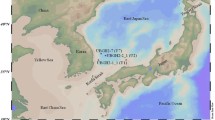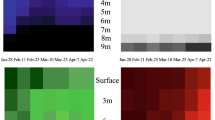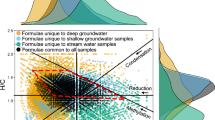Abstract
Recent studies have highlighted the composition and complexity of dissolved organic matter (DOM) in glacial environments. Climate-induced changes to glacier runoff are projected to be an important source of DOM to coastal ecosystems. Photochemical and microbial (termed photo-biochemical) degradation of DOM would determine its fate on the glacier surface and in recipient coastal ecosystems. In order to understand the molecular imprints of photo-biochemical alteration of DOM, in situ field experiments were conducted over a period of 35 days in a coastal Antarctic site and DOM molecularly characterised using ultrahigh-resolution mass spectrometry. We show that the biogeochemistry of DOM is highly complex and intimately connected with microbial and photochemical processes operating individually or in combination. Photo-biochemical processes resulted in shifts in the nitrogen, sulfur, and phosphorous content of the DOM. These processes are also an important mechanism for transforming refractory DOM, like dissolved black carbon and carboxylic rich alicyclic molecules from the snow surface. This study is unique, as it provides new molecular-level information on compounds that comprise the photo- and bio-labile, photo- and bio-refractory, as well as photo- and bio-produced fractions of the supraglacial DOM pool. These insights into the interactions between microbes, light, and specific components of the DOM pool highlight the need for studies focused on the biogeochemistry of supraglacial carbon and its response to a changing climate.



Similar content being viewed by others
References
Antony R, Grannas AM, Willoughby AS, Sleighter RL, Thamban M, Hatcher PG (2014) Origin and sources of dissolved organic matter in snow on the East Antarctic ice sheet. Environ Sci Technol 48:6151–6159
Antony R, Sanyal A, Kapse N, Dhakephalkar PK, Thamban M, Nair S (2016) Microbial communities associated with Antarctic snow pack and their biogeochemical implications. Microbiol Res 192:192–202
Antony R, Willoughby AS, Grannas AM, Catanzano V, Sleighter RL, Thamban M, Hatcher PG, Nair S (2017) Molecular insights on dissolved organic matter transformation by supraglacial microbial communities. Environ Sci Technol 51:4328–4337
Barker JD, Dubnick A, Lyons WB, Chin Y-P (2013) Changes in dissolved organic Matter (DOM) fluorescence in proglacial antarctic streams. Arct Antarct Alp Res 45(3):305–317
Benner R, Biddanda B (1998) Photochemical transformations of surface and deep marine dissolved organic matter: effects on bacterial growth. Limnol Oceanogr 43:1373–1378
Benner R, Ziegler S (1999) Do photochemical transformations of dissolved organic matter produce biorefractory as well as bioreactive substrates? In: Bell C, Brylinsky M, Johnson-Green PC (eds) Microbial Biosystems: New Frontiers. Proceedings of the 8th international symposium on microbial ecology. Atlantic Canada Society for Microbial Ecology, Canada, pp 181–192
Bhatia MP, Das SB, Longnecker K, Charette MA, Kujawinski EB (2010) Molecular characterization of dissolved organic matter associated with the Greenland ice sheet. Geochim Cosmochim Acta 74:3768–3784
Bushaw KL, Zepp RG, Tarr MA, Schulz-Jander D, Bourbonniere RA, Hodson RE, Miller WLD, Bronk A, Moran MA (1996) Photochemical release of biologically labile nitrogen from dissolved organic matter. Nature 381:404–407
Bushaw-Newton KL, Moran MA (1999) Photochemical formation of biologically available nitrogen from dissolved humic substances in coastal marine systems. Aquat Microb Ecol 18:285–292
Cook JM, Hodson AJ, Anesio AM, Hanna E, Yallop M, Stibal M, Telling J, Huybrechts P (2012) An improved estimate of microbially mediated carbon fluxes from the Greenland ice sheet. J Glaciol 58:1098–1108
Cory RM, Kling GW (2018) Interactions between sunlight and microorganisms influence dissolved organic matter degradation along the aquatic continuum. Limnol Oceanogr Lett 3:102–116
D’Andrilli J, Smith HJ, Dieser M, Foreman CM (2017) Climate driven carbon and microbial signatures through the last ice age. Geochem Perspect Let 4:29–34
D’Andrilli J, Cooper WT, Foreman CM, Marshall AG (2015) An ultrahigh-resolution mass spectrometry index to estimate natural organic matter lability. Rapid Commun Mass Spectrom 29:2385–2401
Dittmar T, Paeng J (2009) A heat-induced molecular signature in marine dissolved organic matter. Nat Geosci 2:175–179
Dittmar T, Koch B, Hertkorn N, Kattner G (2008) A simple and efficient method for the solid-phase extraction of dissolved organic matter (SPE-DOM) from seawater. Limnol Oceanogr 6:230–235
Fasching C, Behounek B, Singer GA, Battin TJ (2014) Microbial degradation of terrigenous dissolved organic matter and potential consequences for carbon cycling in brown-water streams. Sci Rep 4:4981
Franko DA, Heath RT (1982) UV-sensitive complex phosphorus: association with dissolved humic material and iron in a bog lake. Limnol Oceanogr 27:564–569
Gonsior M, Peake BM, Cooper WT, Podgorski D, D’Andrilli J, Cooper WJ (2009) Photochemically induced changes in dissolved organic matter identified by ultrahigh resolution fourier transform ion cyclotron resonance mass spectrometry. Environ Sci Technol 43:698–703
Gonsior M, Peake BM, Cooper WT, Podgorski DC, D’Andrilli J, Dittmar T, Cooper WJ (2011) Characterization of dissolved organic matter across the Subtropical Convergence off the South Island, New Zealand. Mar Chem 123:99–110
Goutx M, Acquaviva M, Bertrand J-C (1990) Cellular and extracellular carbohydrates and lipids from marine bacteria during growth on soluble substrates and hydrocarbons. Mar Ecol Prog Ser 61:291–296
Grannas AM, Shepson PB, Filley TR (2004) The photo-chemistry and nature of organic matter in Arctic and Antarctic Snow. Global Biogeochem Cycles 18:GB1006
Grannas AM, Hockaday WC, Hatcher PG, Thompson LG, Mosley-Thompson E (2006) New revelations on the nature of organic matter in ice cores. J Geophys Res 111:D04304
Grannas AM, Jones AE, Dibb J, Ammann M, Anastasio C, Beine HJ, Bergin M, Bottenheim J, Boxe CS, Carver G, Chen G, Crawford JH, Dominé F, Frey MM, Guzmán MI, Heard DE, Helmig D, Hoffmann MR, Honrath RE, Huey LG, Hutterli M, Jacobi HW, Klán P, Lefer B, McConnell J, Plane J, Sander R, Savarino J, Shepson PB, Simpson WR, Sodeau JR, von Glasow R, Weller R, Wolff EW, Zhu T (2007) An overview of snow photochemistry: evidence, mechanisms and impacts. Atmos Chem Phys 7:4329–4373
Hedges JI, Keil RG, Benner R (1997) What happens to terrestrial organic matter in the ocean? Org Geochem 27:195–212
Hertkorn N, Benner R, Frommberger M, Schmitt-Kopplin P, Witt M, Kaiser K, Kettrup A, Hedges JI (2006) Characterization of a major refractory component of marine dissolved organic matter. Geochim Cosmochim Acta 70(12):2990–3010
Herzsprung P, Hertkorn N, Friese K, Schmitt-Kopplin P (2010) Photochemical degradation of natural organic sulphur compounds (CHOS) from iron-rich mine pit lake pore waters—an initial understanding from evaluation of single elemental formulae using ultra-high-resolution mass spectrometry. Rapid Commun Mass Spectrom 24:2909–2924
Hockaday WC, Grannas AM, Kim S, Hatcher PG (2006) Direct molecular evidence for the degradation and mobility of black carbon in soils from the ultrahigh-resolution mass spectral analysis of dissolved organic matter from a fire-impacted forest soil. Org Geochem 37:501–510
Hockaday WC, Purcell JM, Marshall AG, Baldock JA, Hatcher PG (2009) Electrospray and photoionization mass spectrometry for the characterization of organic matter in natural waters: a qualitative assessment. Limnol Oceanogr Methods 7:81–95
Hood E, Fellman J, Spencer RGM, Hernes PJ, Edwards R, D’Amore D, Scott D (2009) Glaciers as a source of ancient and labile organic matter to the marine environment. Nature 462:1044–1048
Hood E, Battin TJ, Fellman J, O’Neel S, Spencer RGM (2015) Storage and release of organic carbon from glaciers and ice sheets. Nat Geosci 8:91–96
Kellerman AM, Dittmar T, Kothawala DN, Tranvik LJ (2014) Chemodiversity of dissolved organic matter in lakes driven by climate and hydrology. Nat Commun 5:3804
Kido Soule MC, Longnecker K, Giovannoni SJ, Kujawinski EB (2010) Impact of instrument and experimental parameters on the repeatability and reproducibility of peaks in ultrahigh resolution ESI FTICR mass spectra of natural organic matter. Org Geochem 41:725–733
Kieber DJ, McDaniel J, Mopper K (1989) Photochemical source of biological substrates in sea water—implications for carbon cycling. Nature 341:637–639
Kieber RJ, Li A, Seaton PJ (1999) Production of nitrite from the photodegradation of dissolved organic matter in natural waters. Environ Sci Technol 33:993–998
Koch BP, Dittmar T (2006) From mass to structure: an aromaticity index for high-resolution mass data of natural organic matter. Rapid Commun Mass Spectrom 20(5):926–932
Koch BP, Dittmar T (2016) Erratum of: From mass to structure: an aromaticity index for high-resolution mass data of natural organic matter. Rapid Commun Mass Spectrom 30:250
Koch BP, Witt M, Engbrodt R, Dittmar T, Kattner G (2005) Molecular formulae of marine and terrigenous dissolved organic matter detected by electrospray ionization Fourier transform ion cyclotron resonance mass spectrometry. Geochim Cosmochim Acta 69:3299–3308
Kragh T, Søndergaard M, Tranvik L (2008) Effect of exposure to sunlight and phosphorus limitation on bacterial degradation of coloured dissolved organic matter (CDOM) in freshwater. FEMS Microbiol Ecol 64:230–239
Kujawinski EB, Behn MD (2006) Automated analysis of electrospray ionization Fourier transform ion cyclotron resonance mass spectra of natural organic matter. Anal Chem 78:4363–4373
Laurion I, Mladenov N (2013) Dissolved organic matter photolysis in Canadian arctic thaw ponds. Environ Res Lett 8:035026
Lindell MJ, Graneèli W, Tranvik LJ (1995) Enhanced bacterial growth in response to photochemical transformation of dissolved organic matter. Limnol Oceanogr 40:195–199
Mazzoleni LR, Saranjampour P, Dalbec MM, Samburova V, Hallar AG, Zielinska B, Lowenthal D, Kohl S (2012) Identification of water-soluble organic carbon in nonurban aerosols using ultra-high resolution FT-ICR mass spectrometry: organic anions. Environ Chem 9:285–297
McCallister SL, del Giorgio PA (2012) Evidence for the respiration of ancient terrestrial organic C in northern temperate lakes and streams. Proc Natl Acad Sci USA 109:16963–16968
McNeill VF, Grannas AM, Abbatt JPD, Ammann M, Ariya P, Bartels-Rausch T, Domine F, Donaldson DJ, Guzman MI, Heger D, Kahan TF, Klán P, Masclin S, Toubin C, Voisin D (2012) Organics in environmental ices: sources, chemistry, and impacts. Atmos Chem Phys 12:9653–9678
Mopper K, Kieber DJ (2002) Photochemistry and the cycling of carbon, nitrogen and phosphorus. In: Hansell DA, Carlson CA (eds) Biogeochemistry of marine dissolved organic matter. Academic Press, USA, pp 456–507
Moran MA, Zepp RG (1997) Role of photoreactions in the formation of biologically labile compounds from dissolved organic matter. Limnol Oceanogr 42:1307–1316
Moran MA, Zepp RG (2000) UV radiation effects on microbes and microbial processes. In: Kirchman DL (ed) Microbial ecology of the oceans. Wiley-Liss, New York, pp 201–228
Musilova M, Tranter M, Wadham J, Telling J, Tedstone A, Anesio AM (2017) Microbially driven export of labile organic carbon from the Greenland ice sheet. Nat Geosci 10:360–365
Nelson DL, Cox MM (2000) Cells. In: Ryan M (ed) Principles of Biochemistry. Worth, New York, pp 21–50
Obernosterer I, Benner R (2004) Competition between biological and photochemical processes in the mineralization of dissolved organic carbon. Limnol Oceanogr 49:117–124
Ohno T, He Z, Sleighter RL, Honeycutt C, Hatcher PG (2010) Ultrahigh resolution mass spectrometry and indicator species analysis to identify marker components of soil and plant biomass-derived organic matter fractions. Environ Sci Technol 44(22):8594–8600
Pautler BG, Simpson AJ, Simpson MJ, Tseng L-H, Spraul M, Dubnick A, Sharp MJ, Fitzsimmons SJ (2011) Detection and structural identification of dissolved organic matter in Antarctic glacial ice at natural abundance by SPR-W5-WATE RGATE 1H NMR spectroscopy. Environ Sci Technol 45:4710–4717
Priscu JC, Tulaczyk S, Studinger M, Kennicutt MC II, Christner BC, Foreman CM (2008) Antarctic subglacial water: origin, evolution, and ecology. In: Vincent WF, Laybourn-Parry J (eds) Polar lakes and rivers. Oxford University Press, UK, pp 119–136
Rignot E, Jacobs S, Mouginot J, Scheuchl B (2013) Ice-shelf melting around Antarctica. Science 341:266–270
Rossel PE, Vähätalo AV, Witt M, Dittmar T (2013) Molecular composition of dissolved organic matter from a wetland plant (Juncus effusus) after photochemical and microbial decomposition (125 year): common features with deep sea dissolved organic matter. Org Geochem 60:62–71
Schmidt F, Elvert M, Koch BP, Witt M, Kai-Uwe H (2009) Molecular characterization of dissolved organic matter in pore water of continental shelf sediments. Geochim Cosmochim Acta 73:3337–3358
Shepherd A, Ivins ER, Geruo A, IMBIE Project Group (2012) A reconciled estimate of ice-sheet mass balance. Science 338:1183–1189
Singer GA, Fasching C, Wilhelm L, Niggemann J, Steier P, Dittmar T, Battin TJ (2012) Biogeochemically diverse organic matter in Alpine glaciers and its downstream fate. Nat Geosci 5:710–714
Sleighter RL, Hatcher PG (2008) Molecular characterization of dissolved organic matter (DOM) along a river to ocean transect of the lower Chesapeake Bay by ultrahigh resolution electrospray ionization Fourier transform ion cyclotron resonance mass spectrometry. Mar Chem 110(3–4):140–152
Sleighter RL, McKee GA, Liu Z, Hatcher PG (2008) Naturally present fatty acids as internal calibrants for Fourier transform mass spectra of dissolved organic matter. Limnol Oceanogr Methods 6:246–253
Sleighter RL, Liu Z, Xue J, Hatcher PG (2010) Multivariate statistical approaches for the characterization of dissolved organic matter analyzed by ultrahigh resolution mass spectrometry. Environ Sci Technol 44(19):7576–7582
Sleighter RL, Chen H, Wozniak AS, Willoughby AS, Caricasole P, Hatcher PG (2012) Establishing a measure of reproducibility of ultrahigh-resolution mass spectra for complex mixtures of natural organic matter. Anal Chem 84:9184–9191
Smith HJ, Foster RA, McKnight DM, Lisle JT, Littmann S, Kuypers MMM, Foreman CM (2017) Microbial formation of labile organic carbon in Antarctic glacial environments. Nat Geosci 10:356–359
Stibal M, Šabacká M, Žárský J (2012) Biological processes on glacier and ice sheet surfaces. Nat Geosci 5:771–774
Stubbins A, Spencer RGM, Chen H, Hatcher PG, Mopper K, Hernes PJ, Mwamba VL, Mangangu AM, Wabakanghanzi JN, Six J (2010) Illuminated darkness: molecular signatures of Congo River dissolved organic matter and its photochemical alteration as revealed by ultrahigh precision mass spectrometry. Limnol Oceanogr 55:1467–1477
Stubbins A, Hood E, Raymond PA, Aiken GR, Sleighter RL, Hernes PJ, Butman D, Hatcher PG, Striegl RG, Schuster P, Abdulla HAN, Vermilyea AW, Scott DT, Spencer RGM (2012) Anthropogenic aerosols as a source of ancient dissolved organic matter in glaciers. Nat Geosci 5:198–201
Thornton DCO (2014) Dissolved organic matter (DOM) release by phytoplankton in the contemporary and future ocean. Eur J Phycol 49:20–46
Tranvik LJ, Kokalj S (1998) Decreased biodegradability of algal DOC due to interactive effects of UV radiation and humic matter. Aquat Microb Ecol 14:301–307
Tranvik LJ, Olofsson H, Bertilsson S (2000) Photochemical effects on bacterial degradation of dissolved organic matter in lake water. In: Bell CR, Brylinsky M, Johnson-Green P (eds) Microbial biosystems: new frontiers proceedings of the 8th international symposium on microbial ecology, Atlantic Canada Society for Microbial Ecology, Canada, pp 193–200
Vähätalo AV, Järvinen M (2007) Photochemically produced bioavailable nitrogen from biologically recalcitrant dissolved organic matter stimulates production of a nitrogen-limited microbial food web in the Baltic Sea. Limnol Oceanogr 52:132–143
Vähätalo AV, Salonen K, Münster U, Järvinen M, Wetzel RG (2003) Photochemical transformation of allochthonous organic matter provides bioavailable nutrients in a humic lake. Arch Hydrobiol 156:287–314
Vähätalo AV, Aarnos H, Hoikkala L, Lignell R (2011) Photochemical transformation of terrestrial dissolved organic matter supports hetero- and autotrophic production in coastal waters. Mar Ecol Prog Ser 423:1–14
Ward ND, Keil RG, Medeiros PM, Brito DC, Cunha AC, Dittmar T, Yager PL, Krusche AV, Richey JE (2013) Degradation of terrestrially derived macromolecules in the Amazon River. Nat Geosci 6:530–533
Wetzel RG, Hatcher PG, Bianchi TS (1995) Natural photolysis by ultraviolet irradiance of recalcitrant dissolved organic matter to simple substrates for rapid bacterial metabolism. Limnol Oceanogr 40:1369–1380
Xu JZ, Grannas A, Xiao CD, Du ZH, Willoughby A, Hatcher P, An YQ (2018) High-resolution mass spectrometric characterization of dissolved organic matter from warm and cold periods in the NEEM ice core. Sci Cold Arid Reg 10:38–46
Yavitt JB, Fahey TJ (1984) An experimental analysis of solution chemistry in a lodgepole pine forest floor. Oikos 43:222–234
Acknowledgements
We thank the Ministry of Earth Sciences (India) and the Director, NCAOR for support. We are grateful for the support from the members and crew of the 33rd Indian Scientific Expedition to Antarctica. Shri M. J. Beg, Director (Logistics), NCAOR, is thanked for providing all necessary logistic support for the sampling, as well as, for the safe transport of samples to Old Dominion University. We also thank the College of Sciences Major Instrumentation Cluster at ODU for their assistance with the FTICR-MS data acquisition. The FTICR-MS analysis was funded by the National Science Foundation (Antarctic Glaciology Program #0739691). We also appreciate the constructive comments provided by reviewers, which allowed us to greatly improve the quality of this manuscript. This is NCAOR contribution number 55/2018.
Author information
Authors and Affiliations
Corresponding author
Additional information
Responsible Editor: Emily H. Stanley.
Electronic supplementary material
Below is the link to the electronic supplementary material.
Rights and permissions
About this article
Cite this article
Antony, R., Willoughby, A.S., Grannas, A.M. et al. Photo-biochemical transformation of dissolved organic matter on the surface of the coastal East Antarctic ice sheet. Biogeochemistry 141, 229–247 (2018). https://doi.org/10.1007/s10533-018-0516-0
Received:
Accepted:
Published:
Issue Date:
DOI: https://doi.org/10.1007/s10533-018-0516-0




